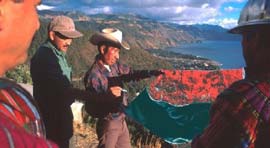Earth Sciences (also referred to as Geosciences), which deals with basic issues surrounding our planet, plays a vital role in the area of energy and raw materials supply.
Earth Sciences comprises subjects such as geology, geography, geological informatics, paleontology, mineralogy, petrography, crystallography, geophysics, geodesy, glaciology, cartography, photogrammetry, meteorology and seismology, early-warning systems, earthquake research and polar research.

Science fiction writers and movie-makers have imagined a world completely covered by an ocean, but what if one really existed? Would such a world support life, and what would this life be like?
ESA could make science fiction become science fact when it finds such a world, if the predictions of a group of European astronomers are correct. The ESA mission Eddington, which is now in development, could be the key.
At the recent ESA co-sponsored ’’Towards Other Earths’’ c

A water-sensing satellite orbits more than 400 miles above Earth. An instrument-packed airplane circles 25,000 feet above three U.S. states and Brazil. Scientists, college students and other volunteers troop into the countryside, armed with sensors and notepads. It’s all about “getting the dirt.” In this case, collecting detailed information about the soil.
The objectives are two-fold — validating soil moisture data gleaned from satellites and working to find the optimum instrument for cond

United Nations-led development efforts in some of the poorest and most remote parts of the globe are being guided by images from space.
The ESA-backed UNOSAT consortium is providing an average of five new satellite-derived maps or data products to UN agencies and non-governmental organisations every week.
The poor Nicaraguan highlands municipality of Matagalpa is just one site among many where UNOSAT-supplied geographical information system (GIS) tools are being used in develop

Warming resulted in part fromfrom human activity
A group of leading climate scientists has reaffirmed the “robust consensus view” emerging from the peer reviewed literature that the warmth experienced on at least a hemispheric scale in the late 20th century was an anomaly in the previous millennium and that human activity likely played an important role in causing it. In so doing, they refuted recent claims that the warmth of recent decades was not unprecedented in the context of the

Study clarifies key chemical reaction in atmosphere
While a breeze over the ocean may cool beach goers in the summertime, a new scientific study has revealed that tiny sea salt particles drifting into the atmosphere participate in a chemical reaction that may have impacts on climate and acid rain.
The research, published in the July 3 online issue of Science Express, could have substantial implications for increasing the accuracy of climate models.
The study by scienti

Through many decades, stories about earthquakes raising or lowering water levels in wells, lakes and streams have become the stuff of folklore.
Just last November, the magnitude 7.9 Denali earthquake in Alaska was credited with sloshing water in Seattle’s Lake Union and Lake Pontchartrain in New Orleans, and was blamed the next day when muddy tap water turned up in Pennsylvania, where some water tables dropped as much as 6 inches.
But the relationship between seismic activity and